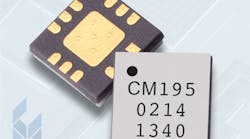A pair of single-pole, double-throw (SPDT) nonreflective GaAs switches has been developed for applications from DC to 18 GHz. Both are supplied in compact 3 × 3 mm RoHS-compliant surface-mount-technology (SMT) housings, differing essentially in insertion-loss performance. Model CMD195C3 exhibits typical insertion loss of 2 dB across its full frequency range, with typical isolation of 37 dB. It has switching speed of typically 1.8 ns and handles +25 dBm typical input power at 1-dB compression. It is controlled with 0 and -5-VDC voltage lines and requires no bias supply. Model CMD196C3 trims typical insertion loss to 1.5 dB through 8 GHz and 1.8 dB through 18 GHz, with similar electrical performance across an operating temperature range of -40 to +85°C. The switches boast typical input third-order intercept point (IP3) of +37 dBm and are well suited for use in broadband microwave radios.
Custom MMIC Design Services, Inc., 1 Park Dr., Unit 12, Westford, MA 01886; (978) 467-4290, FAX : (978) 467-4294.
